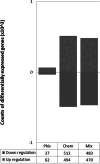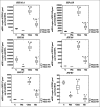Effect of Caffeic Acid and a Static Magnetic Field on Human Fibroblasts at the Molecular Level - Next-generation Sequencing Analysis
- PMID: 39585554
- PMCID: PMC11953221
- DOI: 10.1007/s12010-024-05094-z
Effect of Caffeic Acid and a Static Magnetic Field on Human Fibroblasts at the Molecular Level - Next-generation Sequencing Analysis
Abstract
Due to their properties, numerous polyphenols and a static magnetic field could have therapeutic potential. Therefore, the aim of our research was to investigate the effect of caffeic acid (CA), a moderate-strength static magnetic field (SMF) and their simultaneous action on human fibroblasts in order to determine the molecular pathways they affect, which might contribute to their potential use in therapeutic strategies. The research was conducted using normal human dermal fibroblasts (NHDF cells) that had been treated with caffeic acid at a concentration of 1 mmol/L and then exposed to a moderate-strength static magnetic field. The RNA that had been extracted from the collected cells was used as a template for next-generation sequencing (NGS) and an RT-qPCR reaction. We identified a total of 1,006 differentially expressed genes between CA-treated and control cells. Exposure of cells to a SMF altered the expression of only 99 genes. Simultaneous exposure to both factors affected the expression of 953 genes. It has also been shown that these genes mainly participate in cellular processes, including apoptosis. The highest fold change value were observed for HSPA6 and HSPA7 genes. In conclusion, the results of our research enabled the modulators, primarily caffeic acid and to a lesser extent a static magnetic field, of the apoptosis signaling pathway in human fibroblasts to be identified and to propose a mechanism of their action, which might be useful in the development of new preventive and/or therapeutic strategies. However, more research using other cell lines is needed including cancer cells.
Keywords: Apoptosis; Caffeic acid; Fibroblasts; Next-generation sequencing; Static magnetic field.
© 2024. The Author(s).
Conflict of interest statement
Declarations. Ethical Approval: This article does not contain any studies with human participants or animals performed by any of the authors. Competing Interests: The authors have no relevant financial or non-financial interests to disclose.
Figures






Similar articles
-
The Apoptotic Effect of Caffeic or Chlorogenic Acid on the C32 Cells That Have Simultaneously Been Exposed to a Static Magnetic Field.Int J Mol Sci. 2022 Mar 31;23(7):3859. doi: 10.3390/ijms23073859. Int J Mol Sci. 2022. PMID: 35409218 Free PMC article.
-
Caffeic acid derivatives isolated from Galinsoga parviflora herb protected human dermal fibroblasts from UVA-radiation.Phytomedicine. 2019 Apr;57:215-222. doi: 10.1016/j.phymed.2018.12.022. Epub 2018 Dec 17. Phytomedicine. 2019. PMID: 30785017
-
Impact of fluoride and a static magnetic field on the gene expression that is associated with the antioxidant defense system of human fibroblasts.Chem Biol Interact. 2018 May 1;287:13-19. doi: 10.1016/j.cbi.2018.04.004. Epub 2018 Apr 6. Chem Biol Interact. 2018. PMID: 29630877
-
Anti-apoptotic effect of a static magnetic field in human cells that had been treated with sodium fluoride.J Environ Sci Health A Tox Hazard Subst Environ Eng. 2020;55(10):1141-1148. doi: 10.1080/10934529.2020.1784655. Epub 2020 Jun 25. J Environ Sci Health A Tox Hazard Subst Environ Eng. 2020. PMID: 32586185
-
The effects of static magnetic fields on bone.Prog Biophys Mol Biol. 2014 May;114(3):146-52. doi: 10.1016/j.pbiomolbio.2014.02.001. Epub 2014 Feb 18. Prog Biophys Mol Biol. 2014. PMID: 24556024 Review.
References
-
- Barakat, A. Z., Hamed, A. R., Bassuiny, R. I., Abdel-Aty, A. M., & Mohamed, S. A. (2020). Date palm and saw palmetto seeds functional properties: Antioxidant, anti-inflammatory and antimicrobial activities. Food Measure,14, 1064–1072. 10.1007/s11694-019-00356-5
-
- Colomeu, T. C., de Figueiredo, D., de Matos da Silva, P., Fernandes, L. G. R., & Zollner, R. L. (2022). Antiproliferative and pro-oxidant effect of polyphenols in aqueous leaf extract of passiflora alata curtis on activated T lymphocytes from non-obese diabetic (NOD SHILT/J) mice. Antioxidants (Basel),11(8), 1503. 10.3390/antiox11081503 - PMC - PubMed
MeSH terms
Substances
Grants and funding
LinkOut - more resources
Full Text Sources

